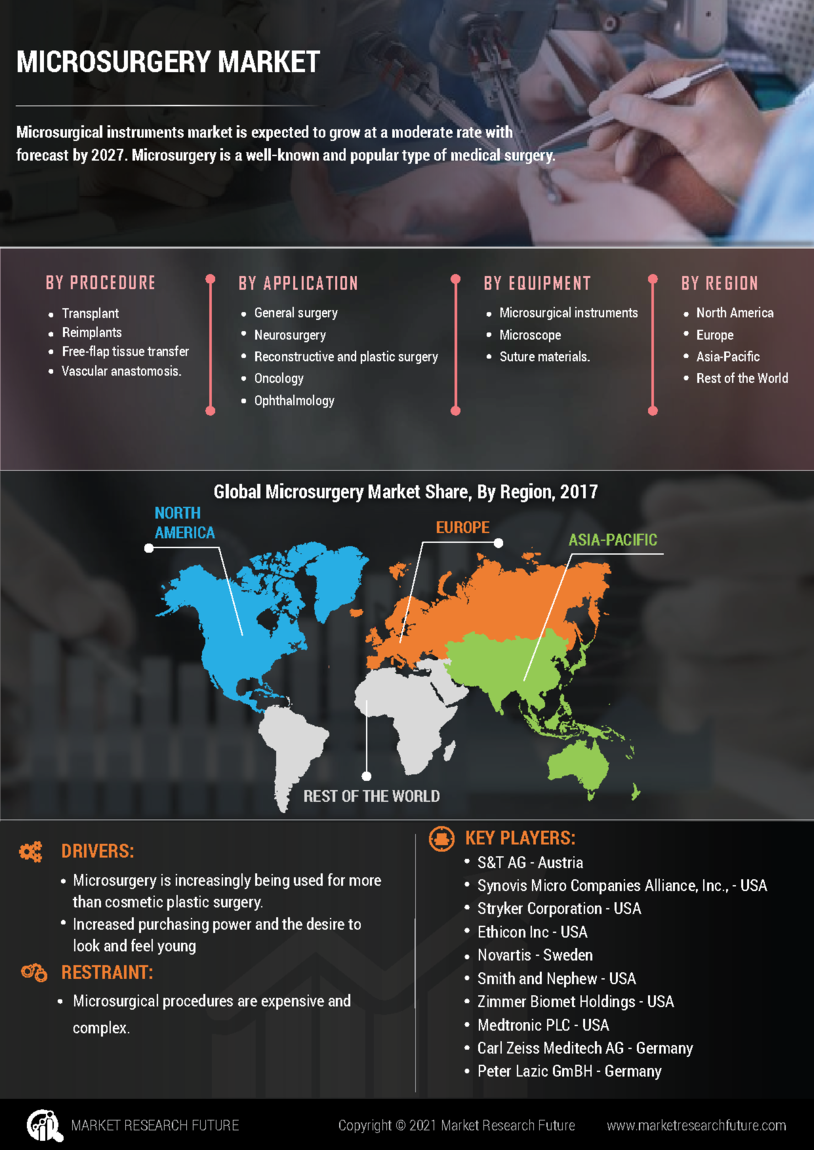Rising Incidence of Trauma Cases
The increasing incidence of trauma cases is a significant driver for the Microsurgery Market. With the rise in road accidents, sports injuries, and other traumatic events, there is a growing need for advanced surgical interventions. Microsurgery Market plays a crucial role in the reconstruction of damaged tissues and organs, particularly in cases involving severe injuries. Data suggests that trauma-related surgeries account for a substantial portion of microsurgical procedures, with estimates indicating that approximately 30% of all microsurgeries are performed for trauma-related cases. This trend underscores the importance of microsurgical techniques in addressing complex injuries, thereby driving demand for skilled microsurgeons and advanced surgical tools. As the prevalence of trauma cases continues to rise, the Microsurgery Market is expected to expand, reflecting the critical role of microsurgery in modern medical practice.
Growing Awareness of Aesthetic Procedures
The rising awareness and acceptance of aesthetic procedures are influencing the Microsurgery Market. As societal norms evolve, there is an increasing demand for cosmetic surgeries that utilize microsurgical techniques. Procedures such as breast reconstruction, facelifts, and body contouring are gaining popularity, driven by the desire for improved physical appearance and self-esteem. Market data indicates that the aesthetic segment of the microsurgery market is expected to witness a growth rate of approximately 12% over the next few years. This growth is attributed to the increasing number of individuals seeking minimally invasive options that offer quicker recovery times and less scarring. As more patients become informed about the benefits of microsurgical techniques in aesthetic procedures, the demand for these services is likely to rise, further propelling the Microsurgery Market.
Technological Innovations in Microsurgery
The Microsurgery Market is experiencing a surge in technological innovations that enhance surgical precision and outcomes. Advanced imaging techniques, such as 3D visualization and augmented reality, are becoming integral to microsurgical procedures. These technologies allow surgeons to visualize intricate anatomical structures with unprecedented clarity, thereby reducing the risk of complications. Furthermore, robotic-assisted microsurgery is gaining traction, as it offers enhanced dexterity and control. According to recent data, the adoption of robotic systems in microsurgery is projected to grow at a compound annual growth rate of over 15% in the coming years. This trend indicates a shift towards more sophisticated surgical tools, which could potentially improve patient recovery times and overall satisfaction. As these innovations continue to evolve, they are likely to redefine the standards of care within the Microsurgery Market.
Increased Investment in Healthcare Infrastructure
Investment in healthcare infrastructure is a pivotal factor propelling the Microsurgery Market. Governments and private entities are increasingly allocating resources to enhance healthcare facilities, particularly in developing regions. This investment often includes the acquisition of advanced surgical equipment and training programs for healthcare professionals. As healthcare systems improve, the demand for specialized surgical procedures, including microsurgery, is likely to increase. Recent reports indicate that healthcare spending in emerging markets is projected to grow by over 10% annually, which could lead to a significant rise in the number of microsurgical procedures performed. Enhanced infrastructure not only facilitates access to advanced surgical techniques but also promotes the development of specialized training programs, thereby ensuring a steady supply of skilled microsurgeons. This trend is expected to contribute positively to the growth of the Microsurgery Market.
Advancements in Training and Education for Surgeons
Advancements in training and education for surgeons are crucial for the growth of the Microsurgery Market. As the complexity of microsurgical procedures increases, there is a pressing need for comprehensive training programs that equip surgeons with the necessary skills. Institutions are now offering specialized courses and simulation-based training to enhance the proficiency of aspiring microsurgeons. Recent statistics indicate that the number of accredited microsurgery training programs has increased by over 20% in the last five years, reflecting a commitment to improving surgical education. This trend not only ensures a higher standard of care but also addresses the growing demand for skilled professionals in the field. As more surgeons become adept in microsurgical techniques, the overall capacity of the Microsurgery Market is likely to expand, meeting the needs of an increasingly diverse patient population.


















Leave a Comment